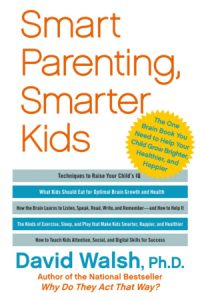Reviews
Review Excerpts
Publishers Weekly – June 13, 2011
The focus of this book by psychologist Walsh (Why Do They Act That Way? A Survival Guide to the Adolescent Brain for You and Your Teen) is “parenting with the brain in mind.” In clear and accessible language, Walsh reports, interprets, and applies recent neuroscience research to help parents understand their kids’ behavior and foster optimum development and use of their children’s amazing brains. Throughout, there is an emphasis on science made practical, as Walsh expands the scope of his previous book to cover a wider range of brain-related behavioral issues from infancy through adolescence. Reminding parents that kids’ brains really are “under construction,” he shares anecdotes from his own family life and clinical experience as he addresses major topics such as IQ and other ways to evaluate learning capabilities; how the brain processes information; the importance of play; and why learning self-discipline is important. Each chapter includes checklists, tool kits, conversation starters, and a list of dos and don’ts, plus a fill-in-the-blank space for parents to plan steps toward change. Citing much of the same research reported in Ellen Galinsky’s Mind in the Making (including the famous marshmallow experiment, about delayed gratification), Walsh has delivered another entertaining and highly elucidating useful volume for the 21st-century parent.
Kirkus Reviews – June 1, 2011
Parents are bombarded with child-rearing manuals and videos, and much of the information can be overwhelming or guilt-inducing. Walsh, a father and a psychologist, knows that products such as “Baby Einstein” do not increase I.Q. and may, in fact, hinder language development. His practical advice is delivered in a breezy style, with many first-person examples to help parents understand how the brain develops and apply that knowledge to raise healthier, happier children. Physical components of brain growth, such as glial cells and hormones, are discussed, and each chapter is coupled with down-to-earth questions or a “Parent Tool Kit” and a simple list of “Do’s and Don’ts.” The author’s voice is not preachy; Walsh even mentions his own mistakes. The author also emphasizes reading and writing, and he touches on a variety of themes, including the special needs of children with ADD, ADHD and Asperger’s. Walsh also examines the teenage brain, including a discussion of the warning signs for depression and suicide, the third-leading cause of death among adolescents. It turns out that our elders’ advice for unstructured play time was good, but today’s parents will appreciate the modern applications and additional resources.
A helpful guide for understanding kids and teenagers.

